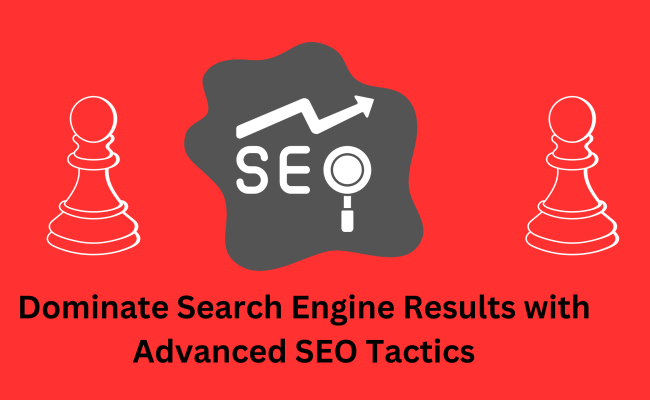Introduction:
In today’s highly competitive digital landscape, businesses and website owners constantly strive to achieve better visibility and higher rankings in search engine results pages (SERPs). While traditional search engine optimization (SEO) strategies are essential, advanced SEO tactics can take your online presence to the next level. This article will explore powerful techniques to help you dominate search engine results and drive significant organic traffic to your website.
1. Comprehensive Keyword Research:
Identifying keywords and phrases is crucial for optimizing your website’s visibility in search engine results. To conduct comprehensive keyword research, consider the following steps:
- Identify keywords and phrases that align with your target audience’s search intent. Put yourself in their shoes and think about what they would search for products, services, or information related to your website.
- Utilize advanced keyword research tools to gain a competitive edge. Tools like Google Keyword Planner, SEMrush, and Ahrefs provide valuable insights into keyword search volume, competition level, and related keyword suggestions.
- Look for long-tail keywords, low-competition keywords, and relevant semantic variations. Long-tail keywords are more specific and targeted, often resulting in higher conversion rates. Low-competition keywords are easier to rank for, giving you a better chance of reaching the top positions in search results. Semantic variations help you capture a broader range of search queries and increase your overall visibility.
2. Technical SEO Optimization:
Optimizing your website’s technical aspects is essential for search engines to crawl, index, and understand your content effectively. Here are key areas to focus on:
- Ensure a clean and logical site structure. Organize your website into logical sections with straightforward navigation and hierarchical order. This helps search engines and users navigate through your site easily.
- Optimize URLs, header tags, and meta tags. Create descriptive and keyword-rich URLs that accurately represent the content of each page. Use header tags (H1, H2, etc.) to structure your content and highlight important sections. Optimize meta tags, including the title and meta descriptions, to provide search engines and users with concise and relevant information about your pages.
- Implement schema markup to enhance the visibility of rich snippets. Schema markup is structured data that provides additional information to search engines about your content, such as product details, ratings, and reviews. Implementing schema markup can help search engines display rich snippets in search results, making your listings more visually appealing and informative.
3. Mobile Optimization:
Optimizing your website for mobile devices is essential with the increasing number of mobile users. Consider the following mobile optimization tactics:
- Optimize your site’s design and layout for a seamless experience across devices. Ensure your website is responsive, automatically adjusting its structure and elements to fit different screen sizes.
- Use responsive design to adapt your content to various devices like smartphones and tablets. This approach ensures that your website looks and functions well regardless of visitors’ devices.
- Optimize page speed to improve the loading time of your mobile site. Mobile users expect fast-loading pages, so optimize images, minimize code, and leverage caching techniques to enhance performance.
- Ensure touch-friendly elements on your mobile site. Make buttons and links large enough for easy tapping, and avoid factors that may require zooming or are difficult to interact with on mobile devices.
- Prioritize mobile-friendly websites to rank higher in mobile search results. Search engines prioritize mobile-friendly websites in their search rankings, so ensuring a seamless mobile experience can improve your visibility and organic traffic.
4. High-Quality Content Creation:
Creating high-quality, valuable content is fundamental to a successful SEO strategy. Consider the following tips for content creation:
- Craft high-quality, informative, and engaging content that provides value to your audience. Focus on addressing their needs, answering questions, and providing actionable insights.
- Create various content types, including articles, blog posts, videos, infographics, and more. Different formats cater to other preferences and can help to answer users’ queries and solve their problems. Research common questions related to your industry or niche and provide comprehensive and well-researched answers within your content.
- Incorporate relevant keywords naturally throughout your content. Ensure that your keywords flow naturally and don’t disrupt the readability or engagement of your content.
- Focus on user readability and engagement. Use subheadings, bullet points, and concise paragraphs to make your content scannable and easy to consume. Include visuals like images and videos to enhance engagement and break up the text.
5. Link Building and Outreach:
Building high-quality backlinks from reputable and authoritative websites is a crucial aspect of advanced SEO. Consider the following link-building and outreach tactics:
- Build high-quality backlinks from reputable and authoritative websites. Seek opportunities to get links from websites relevant to your industry or niche with a solid online presence.
- Develop a comprehensive link-building strategy that includes various tactics such as guest blogging, influencer outreach, and content promotion. Guest blogging allows you to contribute valuable content to other websites in exchange for a backlink. Influencer outreach involves collaborating with influential individuals in your industry to gain exposure and backlinks. Content promotion entails actively promoting your content to attract attention and natural backlinks.
- Focus on acquiring natural and relevant links to strengthen your website’s authority. Aim for backlinks that come from relevant, trustworthy sources naturally. This can be achieved through creating valuable content, fostering relationships with other website owners, and offering unique expertise or resources.
6. User Experience Optimization:
Enhancing your website’s user experience is not only beneficial for users but also improves search engine rankings. Consider the following user experience optimization techniques:
- Improve loading speed to provide a fast and seamless experience. Optimize your website’s code, compress images, leverage browser caching, and utilize content delivery networks (CDNs) to reduce loading times.
- Enhance navigation and overall usability by organizing your content logically and user-friendly. Use clear and intuitive menus, breadcrumb navigation, and internal linking to help users find information quickly.
- Optimize for easy accessibility to ensure all users, including those with disabilities, can access and navigate your website. Use alt tags for images, provide clear text descriptions for multimedia content, and follow accessibility guidelines such as WCAG 2.1.
- Prioritize mobile-friendliness to accommodate the increasing number of mobile users. Use responsive design, optimize images for mobile, and ensure that buttons and links are easily tappable on mobile devices.
- Create intuitive user interfaces that guide users and encourage engagement. Use consistent design elements, clear call-to-action buttons, and engaging visuals to make the user experience enjoyable and interactive.
7. Data-Driven Analysis and Optimization:
To continuously improve your SEO efforts, monitoring and analyzing your website’s performance using web analytics tools is essential. Follow these steps for data-driven analysis and optimization:
- Monitor and analyze your website’s performance using web analytics tools like Google Analytics. These tools provide valuable insights into visitor behavior, traffic sources, and conversions.
- Track metrics like organic traffic, bounce, click-through, and conversion rates. Organic traffic measures the number of visitors coming from search engines. Bounce rates indicate the percentage of visitors who leave your site without further interaction. Click-through rates measure the percentage of users who click on your website in search results. Conversion rates track the number of visitors who complete desired actions, such as purchasing or filling out a form.
- Analyze the data to identify areas for improvement. Look for patterns and trends in the data to gain insights into user behavior and preferences. Identify pages with high bounce rates or low conversion rates to pinpoint potential issues.
- Make data-driven decisions to optimize your SEO strategies and improve your website’s performance. Use the insights from data analysis to make informed decisions about keyword targeting, content creation, user experience enhancements, and overall SEO strategy adjustments.
Conclusion:
Implementing these advanced SEO tactics can significantly improve your website’s visibility and dominate search engine results. Remember that SEO is an ongoing process that requires constant monitoring, analysis, and adaptation. Stay updated with the latest industry trends, algorithm changes, and emerging SEO techniques to maintain your competitive edge and achieve long-term success in the digital realm.








